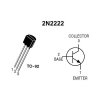Timothypaul26
Well-Known Member
I am trying to make sense of the PWM setup. I am using a L7810CV, as SDS instructed along with a BC547BTA transistor and a 4.7k ohm Rb resistor. This was the only way that I could actually see a
movement in the voltage from ~0 to ~9.5V using the arduino fade example code. I am somewhat new to all of this, I'll just put that out there. But once I introduce the HLG-24H-C1050B it seems to latch at ~10V. Maybe I'm missing something, but with the other examples I was not able to get a voltage change. So if anyone with and advice can help out, I would be grateful.

movement in the voltage from ~0 to ~9.5V using the arduino fade example code. I am somewhat new to all of this, I'll just put that out there. But once I introduce the HLG-24H-C1050B it seems to latch at ~10V. Maybe I'm missing something, but with the other examples I was not able to get a voltage change. So if anyone with and advice can help out, I would be grateful.





 Removing the Rb 4.7K, connecting 5V PWM directly to Base gives me a fade of ~6.5V to ~11V
Removing the Rb 4.7K, connecting 5V PWM directly to Base gives me a fade of ~6.5V to ~11V
